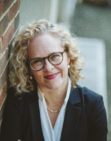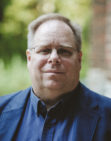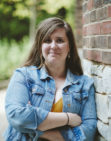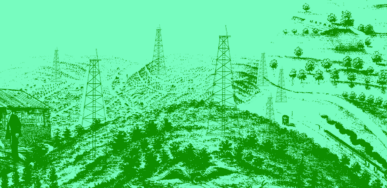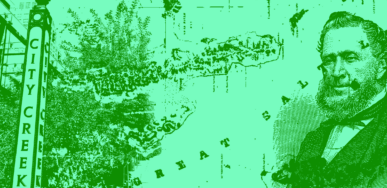Alternative Energy
Kurtis Schaeffer [00:00:00] I'm Kurtis Schaeffer.
Martien Halvorson-Taylor [00:00:01] And I'm Martien Halvorson-Taylor. And this is Sacred and Profane.
Kurtis Schaeffer [00:00:07] If you're new to the show, Martien and I are both professors of Religious Studies at the University of Virginia. This episode is part of our ongoing series on climate change and religions in the United States. We call it Between Heaven and Earth. And the big question we're looking at is how religion has shaped the way Americans think about and live on the land and how that land has shaped religions.
Martien Halvorson-Taylor [00:00:31] Last episode, we explored how the oil industry became intimately linked with evangelical Christianity. But today we're on the hunt for a very different type of energy, which is why we found ourselves, along with some of our colleagues, standing in a crowded parking lot in a small town in the mountains of northern Arizona.
Kim [00:00:57] Thanks for your patience with the parking situation here. Okay, perfect. Well, we'll go ahead. We'll kind of do a little bit of a walk and talk, if that's okay .
Martien Halvorson-Taylor [00:01:08] That's our guide, Kim. She had to circle the lot for nearly 15 minutes to find a spot, even on a weekday afternoon. As parking lots go, I understand why this one was crowded. All around us were stunning, red rock cliffs and mesas dotted with a mix of trees and cacti. The sun was out. It had snowed the day before, and snow still dusted the peaks and high rocks around us. It's what skiers would call a bluebird day. But Kim had asked us to meet her here to show us something a little harder to see. Something this small town is famous for.
Kim [00:01:57] I'm excited to be here with you all. My name's Kim with Sedona Mystical Tours, and we're about to head out on a healing vortex tour near Bell Rock, one of the more commonly known vortex sites here.
Kurtis Schaeffer [00:02:10] Just what is a vortex, you might ask?
Susannah Crockford [00:02:14] Yes. So, the idea of the land being a special sacred place is very strong in Sedona.
Kurtis Schaeffer [00:02:20] That's Susannah Crockford.
Susannah Crockford [00:02:22] So my name is Dr. Susannah Crockford. Generally, I just go by Susannah. I am a lecturer in anthropology at the University of Exeter. There's this idea of the vortexes, which, if you've only ever casually heard of Sedona, that's probably what you've heard about it. That there's these vortexes here. The idea of a vortex is a kind of site of spiraling spiritual, psychic energy, and it is said to be located both in the whole town and the whole area.
Kurtis Schaeffer [00:02:53] Susannah lives in England now, but she lived in and around Sedona for years, doing research into the many New Age movements that have sprung up there. And she says one of the first things that drew spiritual seekers to the town was the vortexes. Many people would claim the vortexes called to them.
Susannah Crockford [00:03:14] It's like a whole sacred geography of the planet, where these kind of intersecting ley lines are meant to be, and there’s these kind of power spots around the world. And some people will just kind of travel from place to place, looking to kind of stay in these kind of different areas, this kind of enhanced spiritual energy that they, they feel drawn to.
Martien Halvorson-Taylor [00:03:38] Many of the sites that are popular today were identified and named by a woman named Paige Bryant in the 1980s.
Kim [00:03:47] Since the 1980s, Paige Bryant was a psychic who would come out here and basically put Sedona on the maps and named the common vortex sites like Bell Rock here, Courthouse. Interesting thing with Paige was she wasn't much of a hiker, from my understanding. And so, there are several hundred, if not thousands of other vortex sites beyond what we find on the maps, too. I find, too, for people who are sensitive to energies, anybody identify as being more as an empath or highly sensitive person, sometimes there's more of a tendency to pick up on the energies of what's been left behind in the space than the energies of the land too, within—now what we get about four or 5 million visitors a year.
Martien Halvorson-Taylor [00:04:35] Sedona is a small town, just under 10,000 people. But it sits at the intersection of spirituality and climate in a way that few places in the U.S. do. For many of the people that come to Sedona, the place itself holds unique spiritual energy that cannot be found elsewhere. It's also in a part of the country that is warming fast, where it is easy to see ecosystems changing as heat creeps up the mountains.
Kurtis Schaeffer [00:05:12] As we hiked out of the parking lot towards the vortex site, we passed through a small grove of juniper and pinyon pine trees.
Kim [00:05:23] The nice thing about being in Sedona is that my job's pretty easy ‘cause there's only more or less two types of trees here to, to memorize. We have our friend, the juniper, and the pinyon pine.
Kurtis Schaeffer [00:05:36] Kim broke off a few needles and passed them around so we could smell the difference between them.
Kim [00:05:42] And when… I'd like to share with you all a little sense that we ask for permission for the trees that like to share some of its leaves. And you never want to take from the first tree or plant that you see when you harvest anything, and you want to leave a third for the tree, a third for the future generations, and harvesting a third for yourself.
Kurtis Schaeffer [00:06:16] Like much of the desert life around us, these trees are extremely sensitive to temperature. They're harder and harder to find at low elevations. Longer, hotter summers and more intense wildfires mean that many species that once thrived in Sedona can no longer endure.
Kim [00:06:38] The javelina, they can be mistaken as pigs. They're actually closer related—they're in the rodent family, but they're an indicator species that they like… They have this kind of like Goldilocks, just-right environment, which is typically in those elevations that have like the pinyon and the juniper. Recently, in the past couple of years in Flagstaff, which we're at about 6300 feet, 63 to 6800 feet, we've seen a lot more javelina up there, which is very, very unusual. So that's just something that I've witnessed in the past few years.
Martien Halvorson-Taylor [00:07:24] But at the same time that javelina and pinyon are retreating up the mountain, human beings are coming here in droves, drawn by the landscape and by Sedona’s reputation as a center of New Age practices. And while many of us probably have some idea of what we mean when we're talking about the New Age, I think it's worth pausing for a real definition.
Susannah Crockford [00:07:50] The idea of the New Age movement comes from the seventies and eighties, and there were books and speakers and the kind of gurus, if you want to use that word. It was specifically saying that this new age was kind of a shift in astrological ages was going to happen soon. And it's this kind of idea that this current era is kind of corrupted, right? And a lot of the corruption is associated with what you might call industrial society. And that this is going to end, and this new era of peace and harmony, where we have a higher spiritual level of kind of consciousness or awareness will come into being. In New Age spirituality, they purposefully take practices from other religious traditions, especially from Buddhism, Tibetan Buddhism in particular, Native American practices in North America, because obviously that's quite familiar to them, especially being in Arizona, where you have reservations very close. So, they pick and choose from certain religions because they, they see them all as coming from the same source.
Kurtis Schaeffer [00:08:55] As someone who studies Tibetan Buddhism, I really noticed that when we were in Sedona. You'd see Buddhist prayer flags, or carved crystal Buddhas, next to bundles of sage and dream catchers, or Catholic prayer candles.
Susannah Crockford [00:09:09] And they don't really see a conflict with other forms of spirituality because they see all religion as being from the same essence. This is a very theosophical idea, but it's all an expression of the same divine truth of the universe. Everything in the universe is composed of energy, and all energy vibrates at a certain frequency.
Kim [00:09:31] From here, can you start to bring your awareness of the qualities from the earth, from the nourishment, from the support, nurturing care for all that she provides. And allowing that to flow up through the body from the soles of the feet.
Kurtis Schaeffer [00:09:54] And this is not unique to New Age religion. Invention and reinvention are what religions do.
Kim [00:10:00] Becoming aware of the electromagnetic fields from the earth. The electromagnetic field at the heart.
Martien Halvorson-Taylor [00:10:15] And the vortexes themselves seem like a way to physically link all those traditions. Sedona is one of the places where people come to find this energy, but so are a variety of sites around the world—sites often linked to religious practices like Stonehenge or the Great Pyramids in Egypt.
Kim [00:10:37] [In the background] Love and gratitude and compassion…
Kurtis Schaeffer [00:10:42] In our time in Sedona, people often spoke about the landscape itself and the power that it held for them. That's something Susannah Crockford noticed during her time there as well. But she said it didn't usually translate into a sense of urgency about how the landscape itself was changing as the weather grew warmer.
Susannah Crockford [00:11:03] I would ask them, how do you follow your spiritual path? And they would just say, well, it's just really about being close to nature. But then the interesting thing about all of this kind of veneration of nature and that the land is that it didn't actually really translate into a level of environmental consciousness or action. I don't recall many people talking about something like climate change.
Martien Halvorson-Taylor [00:11:24] That's a key finding of Susannah's research. Climate change can feel too nebulous to connect to a particular place, especially when there are other pressures that are more visibly at work. Sedona has seen rising temperatures, but it's also seen much more immediate stresses, such as millions of people who come to this tiny town of 10,000 each year.
Kim [00:11:51] Yeah. What I find to be really interesting is just the, the periods of change over time, just from the rocks. Like we were mentioning, this rock that we're standing on, which is about 340 million years old, since humans have been here, the, the impact that that's had and how unsustainable it is for the landscape, for the environment, especially like 4 to 5 million visitors that we get a year just in Sedona now. And the impact that that can have on the land. And so not necessarily in terms of like climate change specifically.
Kurtis Schaeffer [00:12:28] Does any of that change how you see this place? How does it change the energy to have to share it with 5 million people?
Kim [00:12:36] Yeah, absolutely. When I first came to Sedona, probably around 2008, I didn’t have to worry about parking. You know, you can just pull up if you walk right up to the trails. And you could find more solitude on the trails with less people. And I think today what's hurtful or exciting to me is what can sometimes be a disrespect for the trails or for the landscape. And so, we're going to one of these areas, but sharing the experience with hundreds of people and their dogs and children running around. And so, I would say that there's less of that potential for people of being able to find the opportunity, to find solitude, to find a sacred space to be able to just tune in, to listen more, into being more in the present feeling body than having to filter out any distractions from the outside.
Martien Halvorson-Taylor [00:13:46] Susannah mentioned that many New Age believers see our life on Earth as temporary, simply a pitstop on the way to a higher plane.
Susannah Crockford [00:14:00] The third dimension is the dimension that we live in, right, with matter and flesh and suffering. And when we ascend, we're meant to ascend beyond all that. And this kind of transcendental perspective, I think, really undermines the ability to kind of work collectively in this world for social problems that we face now that have systemic causes like climate change.
Kurtis Schaeffer [00:14:24] It's easy to come to a uniquely beautiful place like Sedona and expect it to be radically different than where you came from. But in the end, our trip there highlighted that the problems facing Sedona are the problems facing most of America. People are trying to align their ways of living with their commitments. They're trying to untangle commerce and spirituality. They're often looking for individual solutions to what are, in fact, collective problems.
Susannah Crockford [00:14:53] I think that in many ways they are very similar to a lot of other people in America in that, you know, the average day in the life of someone who's involved in New Age spirituality looks like, you know, the average day in the life of anyone else in a small town in America. Right? You get in your car, you go to the store, you go to your job. Although people care about the environment—they don't want it to be polluted—they also don't want their lives to change. They basically want to continue doing the same things they're always doing, which are the same things that everyone else has been doing.
Martien Halvorson-Taylor [00:15:39] At the end of our time with Kim at the Vortex, we headed back to the parking lot.
Kurtis Schaeffer [00:15:45] Okay.
Martien Halvorson-Taylor [00:15:47] We said goodbye quickly because there were vehicles idling and waiting for our spot. We all got into our car, and we drove back downtown and went to the store.
Kurtis Schaeffer [00:16:23] Sacred & Profane was produced for the Religion, Race, and Democracy Lab at the University of Virginia. This episode was made possible by a grant from the National Endowment for the Humanities. Our senior producer is Emily Gadek. Thank you to Kim at Sedona Metaphysical Tours. We also spoke with Susannah Crockford. Her book on New Age religion is Ripples of the Universe: Spirituality in Sedona, Arizona.
Martien Halvorson-Taylor [00:16:52] Music for this episode comes from Blue Dot Sessions. You can find out more about our work at religionlab.virginia.edu.
The towering mesas, fiery red rocks, succulent greenery, and soaring blue skies of Sedona, Arizona have inspired awe and captured the imagination for as long as humans have known them. To this day, Indigenous Peoples consider the land sacred; each spring, the Yavapai-Apache hold a ceremony there to celebrate the site as the place where humanity was birthed by the Great Spirit Mother.
Since the 1980s, however, the majority of those questing for spiritual connection to the land have been primarily white, New Age seekers. Professional psychic Page Bryant had drawn Sedona into the popular imagination by naming four of its mesas “power vortexes.” These vortexes, she claimed, contained potent mystical energy vibrations that could induce both physical and spiritual healing. And Bryant is not the only one who finds Sedona’s landscape compelling: with a population of just over 10,000, Sedona now hosts more than 3 million tourists annually — many of whom come drawn by the vortexes and the many businesses catering to spiritual seekers that have sprung up in town.
Sedona’s stunning vistas are also uniquely vulnerable to climate change, as summers in Arizona are growing longer and winters warmer faster than most of the rest of the country. We spoke with scholar Susannah Crockford about her own time spent in Sedona, and the tension between a movement that may love the landscape but prioritizes individual healing over collective action. And our hosts headed to Sedona to experience first hand how New Age practices acknowledge a rapidly changing landscape.
Additional Reading
Crockford, Susannah. Ripples of the Universe: Spirituality in Sedona, Arizona. University of Chicago Press, 2021.
Additional Credits
Our guest are Susannah Crockford and Kim from Sedona Mystical Tours. Additional production help from Rebecca Bultman, Erin Burke, and Devin Zuckerman. This episode was funded by a grant from the National Endowment for the Humanities.


